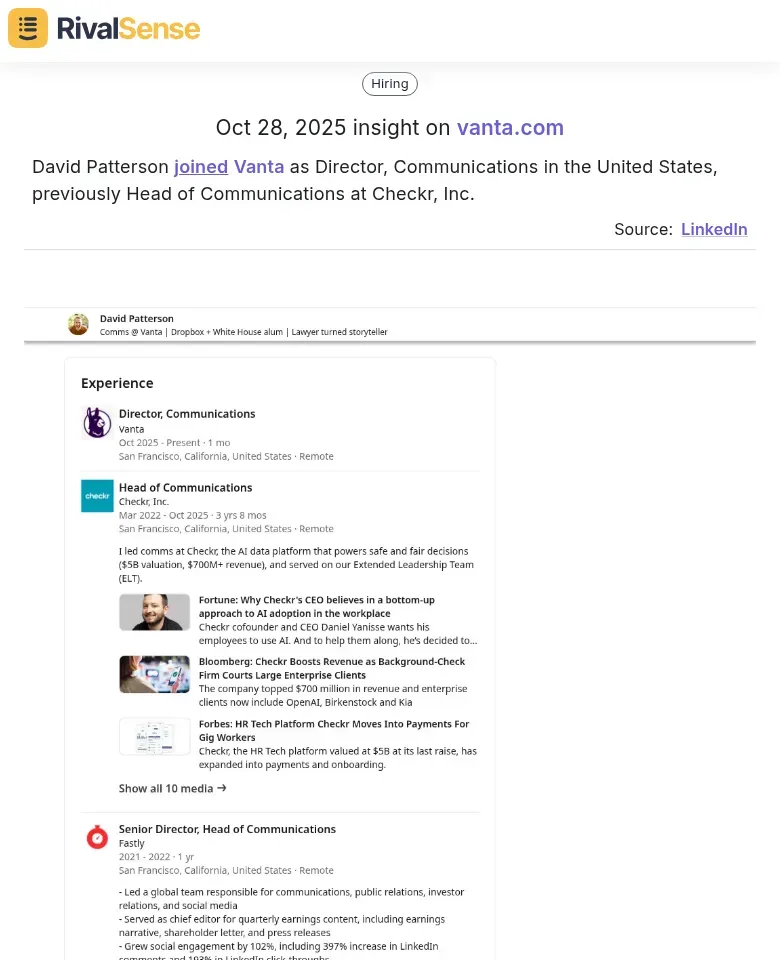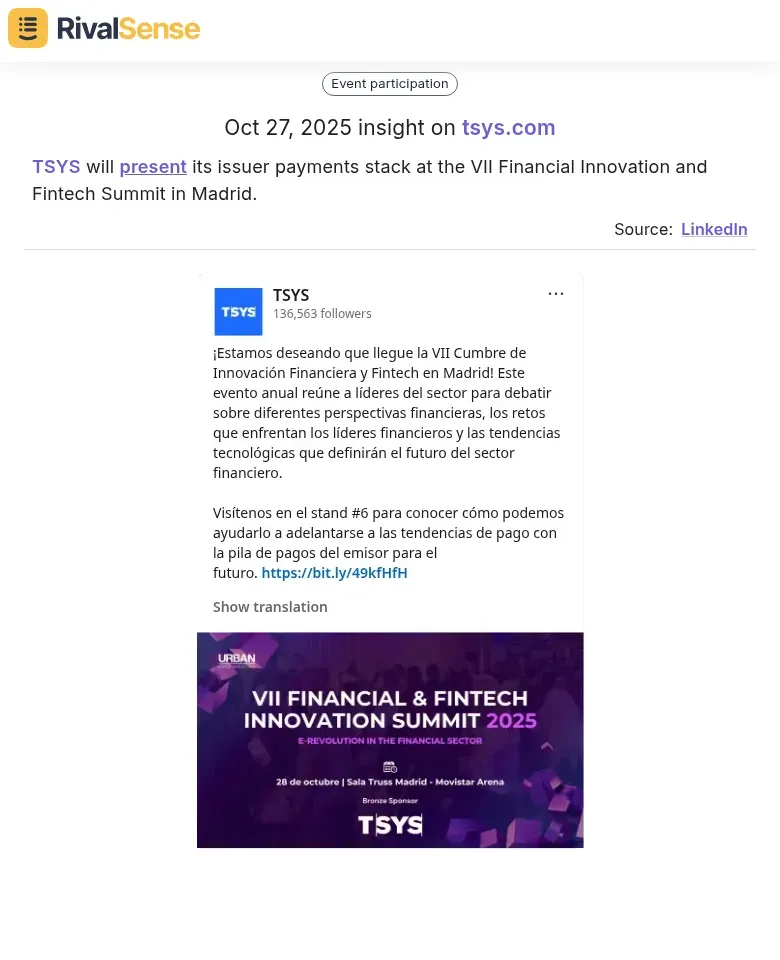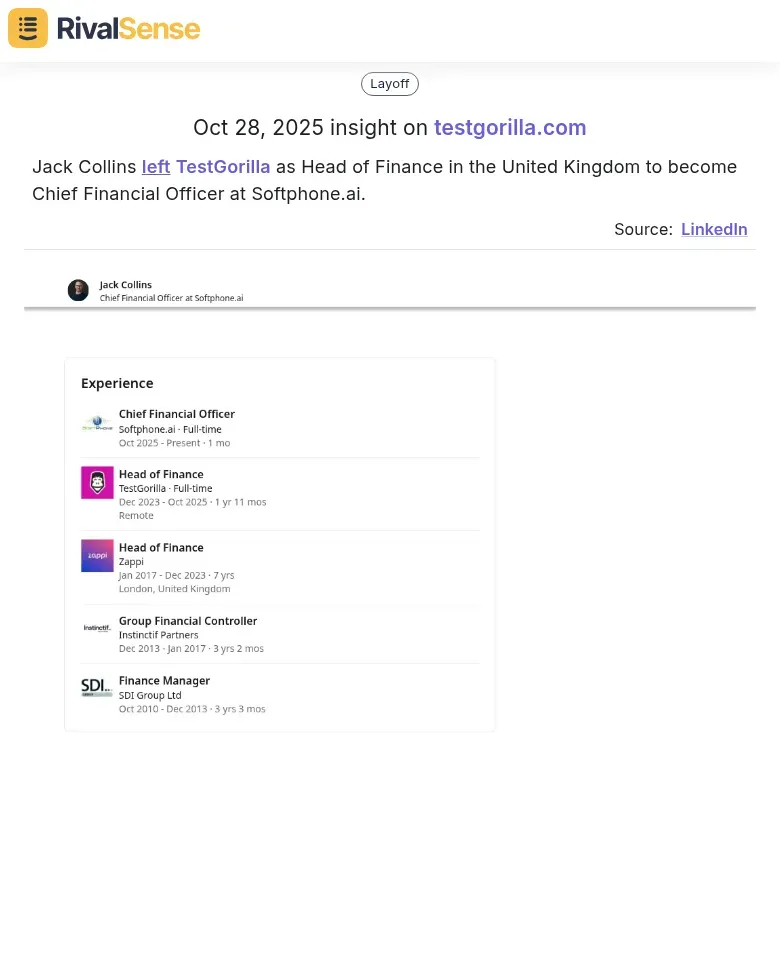LinkedIn Competitive Analysis: Unlock Key Account Growth Insights
In today's B2B landscape, LinkedIn is more than a networking platform—it's a goldmine for competitive intelligence that can drive significant growth. Tracking competitor movements on LinkedIn provides real-time strategic value by uncovering hiring trends, product launches, and partnership announcements that impact your market position. For instance, if a rival posts about expanding their sales team, it signals untapped market opportunities you can capitalize on immediately. Real-time insights from LinkedIn, such as content engagement spikes or key personnel changes, empower agile business strategies, helping you pivot quickly to seize advantages and address gaps.
Competitive intelligence on LinkedIn also reveals market weaknesses; by analyzing competitor posts or customer feedback, you can identify underserved niches and refine your offerings. To get started, follow these actionable steps:
- 📊 Monitor competitor company pages for daily updates on posts and announcements.
- 🔔 Use tools like RivalSense to track metrics like follower growth and engagement rates automatically.
- 💼 Set up alerts for competitor job postings to infer expansion plans and talent needs.
- 📈 Analyze their content strategy weekly to spot emerging trends and adjust your messaging.
This proactive approach transforms LinkedIn from a passive tool into an active driver of account growth, ensuring you stay ahead in dynamic markets.
Tracking Key Personnel Changes to Anticipate Competitor Strategy Shifts
Monitoring key personnel changes on LinkedIn offers critical intelligence for predicting competitor strategy shifts and market movements. When executives join or depart, their backgrounds can reveal strategic priorities—for example, a new CMO from a tech firm may signal a digital transformation push, while a departing CFO could indicate financial restructuring. By tracking talent flow between competitors, you can anticipate intensified competition or emerging industry trends, such as a surge in sustainability hires pointing to eco-friendly market shifts.
For instance, RivalSense recently tracked that David Patterson joined Vanta as Director, Communications in the United States, previously Head of Communications at Checkr, Inc.

This type of insight is valuable because it helps you anticipate changes in competitor communication or marketing strategies, allowing you to adjust your own initiatives proactively to maintain competitive parity. Implement these practical steps to leverage personnel insights:
- ⚠️ Set up LinkedIn alerts for updates on competitor executives and key employees.
- 🔍 Review new hires' past roles to infer strategic priorities and potential new directions.
- 📉 Track departures for signs of internal turmoil or restructuring that could create opportunities.
- 🗺️ Map talent movements across the industry to identify broader trends and adjust your hiring or training plans.
Monitoring Competitor Presence at Industry Events for Market Intelligence
Keeping tabs on competitor participation in industry events provides invaluable market intelligence that can shape your strategic growth initiatives. By observing which events your competitors attend, speak at, or sponsor, you can assess their focus areas, innovation priorities, and resource allocations. This knowledge helps you benchmark your own event strategy, ensuring you don't miss key gatherings where rivals are building visibility and credibility.
For example, RivalSense reported that TSYS will present its issuer payments stack at the VII Financial Innovation and Fintech Summit in Madrid.

This insight is valuable because it signals TSYS's commitment to innovation in payments, allowing you to identify emerging trends, anticipate product launches, and refine your competitive positioning in the fintech space. To systematically gather event intelligence, follow this checklist:
- 📅 Create a centralized spreadsheet to track competitor event participation, including dates, locations, and roles (e.g., speaker, sponsor).
- 🔎 Set up Google Alerts for competitor names combined with keywords like "conference" or "summit" to catch announcements.
- 📱 Follow competitor social media accounts and monitor event-specific hashtags for real-time updates and post-event content.
- 🎤 Attend key events where competitors are present to gather firsthand intelligence on demonstrations and networking opportunities.
- 📊 Analyze post-event materials such as presentation slides, recordings, and press coverage to extract actionable insights.
Extracting Actionable Insights from Competitor Content and Engagement
Analyzing competitor content and engagement on LinkedIn unlocks actionable insights that can enhance your marketing and sales efforts. Start by examining their content themes, messaging, and value propositions to understand their positioning—for instance, if a rival emphasizes 'AI-driven solutions,' you can highlight your unique differentiators to stand out. Regularly tracking posts, hashtags, and article shares helps identify what resonates with their audience, enabling you to adapt your strategy for better results.
Next, measure engagement metrics like likes, comments, shares, and click-through rates to gauge content effectiveness. High engagement on educational content might indicate a preference for value-driven approaches, while low interaction on promotional posts could reveal audience fatigue. Compare these metrics across competitors to spot industry trends, such as the superiority of how-to guides over sales pitches, and use this data to refine your own content calendar. To translate these insights into growth, consider this actionable checklist:
- 📝 Identify top-performing content types (e.g., case studies, infographics, videos) and integrate similar formats into your strategy with enhanced value.
- 🎯 Analyze audience segments targeted in competitor posts to uncover new market opportunities or pain points.
- 💬 Use comments and feedback on competitor content to refine your sales pitches and address common customer concerns.
- 🔄 Update your analysis monthly to adapt to shifting strategies and ensure sustained engagement and lead generation.
Implementing a Systematic Approach to LinkedIn Competitive Analysis
Adopting a systematic approach to LinkedIn competitive analysis turns raw data into a strategic advantage that fuels informed decision-making. By setting up continuous monitoring processes, you can consistently track competitor activities, from company page updates to key employee posts, and integrate these insights with other intelligence sources for a holistic view. Tools like RivalSense automate this tracking, delivering weekly reports that highlight trends such as share-of-voice, engagement rates, and audience sentiment, saving you time and reducing manual errors.
For instance, RivalSense provided this insight: Jack Collins left TestGorilla as Head of Finance in the United Kingdom to become Chief Financial Officer at Softphone.ai.

This type of personnel change insight is valuable because it can indicate financial strategy shifts, potential funding activities, or internal challenges, enabling you to prepare for market dynamics and adjust your financial planning or competitive tactics. To build an effective system, follow this practical framework:
- 🛠️ Use competitive intelligence tools to monitor your top 5 competitors' LinkedIn pages, key employees, and engagement metrics automatically.
- 📋 Schedule weekly reviews of updates, follower growth, and content themes to stay current with market movements.
- 🔗 Cross-reference LinkedIn insights with data from website traffic, review platforms, and industry reports to validate trends and identify correlations.
- 📊 Develop actionable dashboards that visualize competitor strengths and gaps, such as underutilized content formats or untapped audience segments, to guide your strategy refinements.
- ✅ Maintain a checklist: monitor alerts for major announcements, track talent movements, and correlate insights with sales data to drive data-driven decisions.
Conclusion: Turning LinkedIn Insights into Sustainable Competitive Advantage
LinkedIn competitive analysis transforms scattered data into a powerful tool for achieving sustainable growth and long-term market leadership. By consistently tracking competitor content themes, engagement patterns, and talent movements, you can uncover strategic shifts and adapt proactively to changing dynamics. For example, monitoring key account executives' posts for client wins or industry insights helps you identify emerging opportunities and refine your targeting efforts.
Over time, ongoing monitoring builds a dynamic competitive landscape that allows you to anticipate moves, mitigate threats, and seize advantages before others. To maintain this edge, implement these practical steps: set up alerts for competitor pages and key employees, analyze shared content weekly for trends, and use insights to continuously improve your messaging and outreach. By embedding these practices into your routine, you can secure a lasting competitive advantage and drive account growth effectively.
Ready to streamline your competitive analysis? Try RivalSense for free at https://rivalsense.co/ to access automated tracking of competitor product launches, pricing updates, event participations, and more—all delivered in a weekly email report. Get your first competitor report today and start turning insights into action!
📚 Read more
👉 Mapping Competitor Moves: Transport Industry Productivity Tactics
👉 Competitor Financials & M&A Cheat Sheet: Track Hiring for Insights
👉 Leveraging Personnel Changes for Competitive Insights
👉 Competitor Market Research Reports: 5 Steps to Effective Analysis
